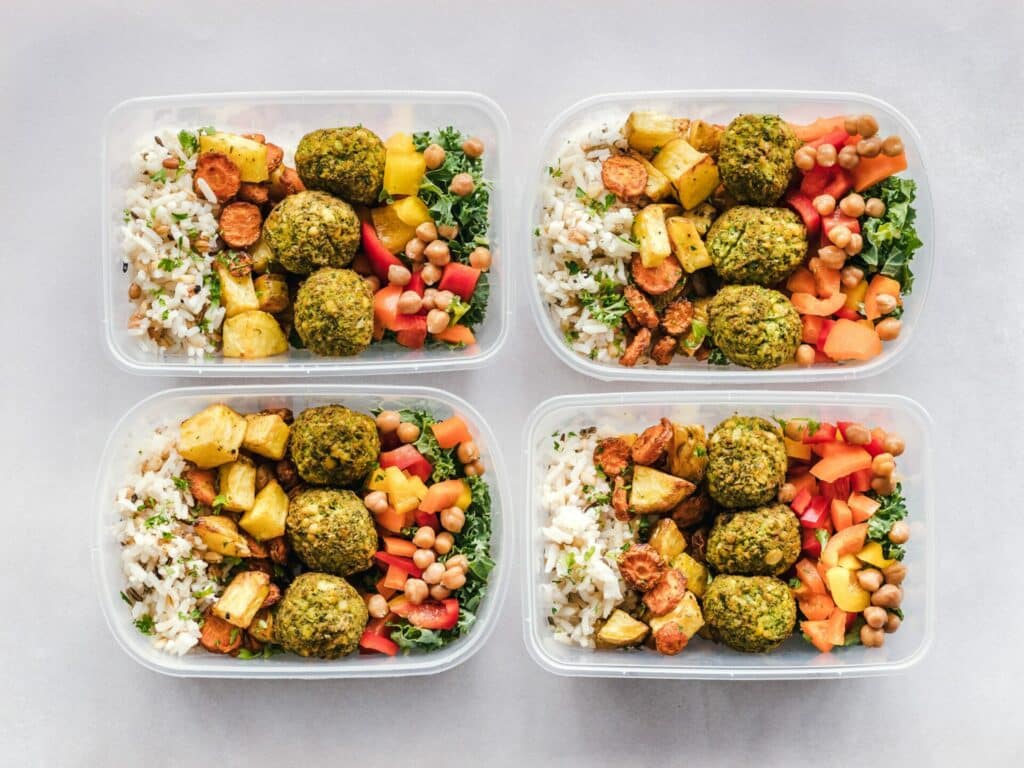Meal planning on a budget can feel overwhelming. Constantly being fed confusing nutrition information, uncertainty about where to grocery shop, food budgeting, and feeling like you don’t have the time to plan out meals may often leave you feeling uncertain.
According to the U.S. Bureau of Labor Statistics, the average American household spends $3,935 per month on food, close to 10 percent of total disposable income. Back in the 1900s, food costs were closer to 40 percent of income and by 1950, had dropped to 30 percent. As society evolves, the food market, cost breakdown, and spending have adjusted to match our lifestyles. According to the Food Industry Association, 29 percent of Americans plan meals a week at a time, while 42 percent of consumers plan only a few days in advance.
It’s no secret that meal planning and preparation can help to cut food costs. Unnecessary food purchases, last-minute decisions and food waste are major contributors to higher expenses.
At Skyterra Young Adult, we help our guests develop a nutrition plan for home that often involves meal planning because, as a whole, it ensures they will receive the nutrients they need to thrive on a weekly basis all while saving money and time. As you begin to make your own changes, find small adjustments to add nutritive value and joy to your meals that will set you up for success for sustainable lifestyle changes.
How to Stick With Your Grocery Budget
1. Avoid Unnecessary Foods Costs
Approaching a meal without a plan, whether it’s ordering in, going out, or picking up last-minute ingredients at the store, food costs can add up rather quickly. It’s estimated that eating out costs close to double the cost of a home-cooked meal. With a small amount of time set aside each week to plan out meals, food costs can decrease drastically.
2. Batch Cook
Often the idea of batch cooking can feel boring and monotonous, eating the exact same meal day after day. Batch cooking can be understood and implemented in many different ways. Buying and cooking bulk ingredients to make numerous meals and/or sides at once can not only save money, but it can save time and energy. Having a meal prepared can eliminate last-minute, impulsive decisions around food. Find a way of batch cooking that works best for you and your lifestyle.
- Multiple of the same meal: If you are someone that doesn’t mind eating a similar meal a few days in a row, cooking in large quantities in ready-to-eat, pre-portioned containers could be right for you.
- Cook and freeze: Taking a similar approach to the above, freezing a few meals to save for later is a great option, especially if you enjoy slightly more diversity. Purchasing freezer-safe storage containers are a great investment in your health journey.
- Easy lunch and leftovers: Lunch is often pushed to the side. The day gets away from you and the last thing on your mind is stopping to make or buy lunch. Having leftovers from the day prior is a strategy to save money and time, and promote health. Either cooking multiple servings of the full meal or a portion of the meal (e.g., grains, roasted vegetables, proteins, etc) will ease preparation down the road.
3. Become Savvy with Coupons and Savings
Becoming the next “Extreme Couponer” may not be in your future, but you can save a few dollars if you have a plan going into the grocery store. Often, grocery stores will send individual coupons based on buying history. In continuing to buy similar products, you may find yourself receiving more coupons. Brand to brand, prices may differ significantly. As a general rule of thumb, store-branded products are cheaper than their name-brand counterparts. Shop around for different grocery stores within your area to compare product prices.
How to Plan Your Budget
Creating a budget can be challenging, but sticking to the budget is the hardest part. Coming up with a strategy when budgeting is a necessity.
A basic rule of thumb presents a range between eight to twelve percent of your usable income that can be allotted to food costs. Depending on your comfort level and desires, you could fall higher or lower on this range. Now that the weekly budget is set, consider a few variables prior to making your shopping list and trip.
- Meals being prepared each week: Consider how many meals you plan to prepare at home versus how many meals you’ll be eating in another location, whether at work, school, restaurant, party, social gathering, etc.
- Mouths to feed: Take into account how many people you’ll be cooking for on a daily basis.
- Frequency of shopping trips: Weekly shopping trips work for the majority of people, but this may not be for you. Consider how many trips to the grocery store you’ll be taking weekly. If you plan to decrease the frequency, frozen or canned fruits and vegetables can be a great option.
- Location and cost of living: No doubt about it, location and cost of living matter when budgeting. Those that live in more expensive areas may have to budget slightly more for weekly groceries.
Our Tips for A Successful Shopping Trip
You may be surprised that the majority of your nutrient-dense foods will fit nicely into your budget. With a little planning, creativity, and thought, you can develop a plan that feels budget-friendly, sustainable, and health-focused.
1. Develop a Weekly Menu
It’s much easier to stick to a budget when you have a plan. Planning meals ahead is a simple way to have a purpose at the store. A weekly meal menu will not only assist in budgeting but help with maintaining a weekly menu full of nutritious meals.
At Skyterra Young Adult, guests are encouraged to follow a weekly meal template, with fun, themed meals each night. Examples include “Meatless Mondays,” “Grain Bowl Night,” “Casserole Night,” “Poultry,” “Seafood,” etc. This system allows our guests to add diversity among meals while ensuring nutrient density is maintained.
2. Don’t Skip the Grocery List
Making a list and sticking to it is challenging, but very beneficial when trying to adhere to a budget. A grocery list is a great way to be prepared and plan ahead for the store. The combination of a meal plan and grocery list will ensure that you are prepared for meal time to eliminate any unnecessary costs and energy toward food.
At Skyterra, guests are supported in making grocery lists for their first couple weeks at home with foods that they know will fit into their daily life upon their return, whether they are students or in the workforce. With varying guest backgrounds, everyone is met where they are on an individual and personal basis.
3. Shop Local and Seasonal Products
The benefits of local and seasonal products are outstanding. Not only can products be cheaper, but they are often packed with stronger flavors and colors, and more even more nutrients, adding a new dynamic to your dish. These products tend to be in abundance, making prices more budget-friendly. Farmers’ markets, local delis and markets, and produce stands can be a great way to support your local farmers and small businesses.
At Skyterra, guests are encouraged to shop locally and seasonally. With a seasonal menu, guests are taught how to adjust a rotating menu to enhance nutritional value using fresh produce that is locally sourced and primed. On occasion, guests are taken to the farmers market, where they gain real-life experience choosing and purchasing these products.
4. Price and Store Compare
It’s no secret that some grocery stores are more expensive than others. According to a study conducted by Business Insider, “specialty” grocery stores, such as Whole Foods, can be up to 19% more expensive than general stores such as Walmart. In the same analysis, meat products were of the highest price difference, noted as 40% higher at Whole Foods compared to general stores. Comparing prices and products between stores is essential. Using store brands or even shopping at multiple grocery stores weekly to gather all products needed can be helpful.
Guests at Skyterra Young Adult are given hands-on experience navigating the grocery store, creating a budget, and price comparing to ensure essential products are obtained. Within this walk-through tour at the store, our on-site Registered Dietitian and Executive Chef show tips and tricks when choosing the best product and price.
5. Determine Priorities on Grocery List
A successful grocery trip also needs a backup plan. Determining priorities on your list is important. To start, decide which products are “primary” and “secondary,” on your list. With this separation, guarantee all priority products are bought first then additional items can be added to stay within budget.
Skyterra guests are taught substitutions for everyday items if there is low stock or the budget will not allow for that particular item to be purchased that week. Sometimes, if a similar item is on sale, that option is chosen for purchase. Guests are encouraged and educated to make sauces, and spice blends, and use alternative products to make menu recipes.
In Conclusion
When planning your budget, meals, and grocery shopping, we at Skyterra Young Adult encourage you to find a rhythm that works for you. Each person’s operation will look slightly different. Giving yourself the flexibility to enjoy your favorite foods, eating balanced meals, and adhering to a budget can seem like a challenge, but with patience and practice, it will become like second nature. Setting aside 20-30 minutes each week to plan out meals can get you off to a great start. We encourage you to have fun with meals and use new recipes, products, and grocery stores to make the process more enjoyable and budget friendly.






